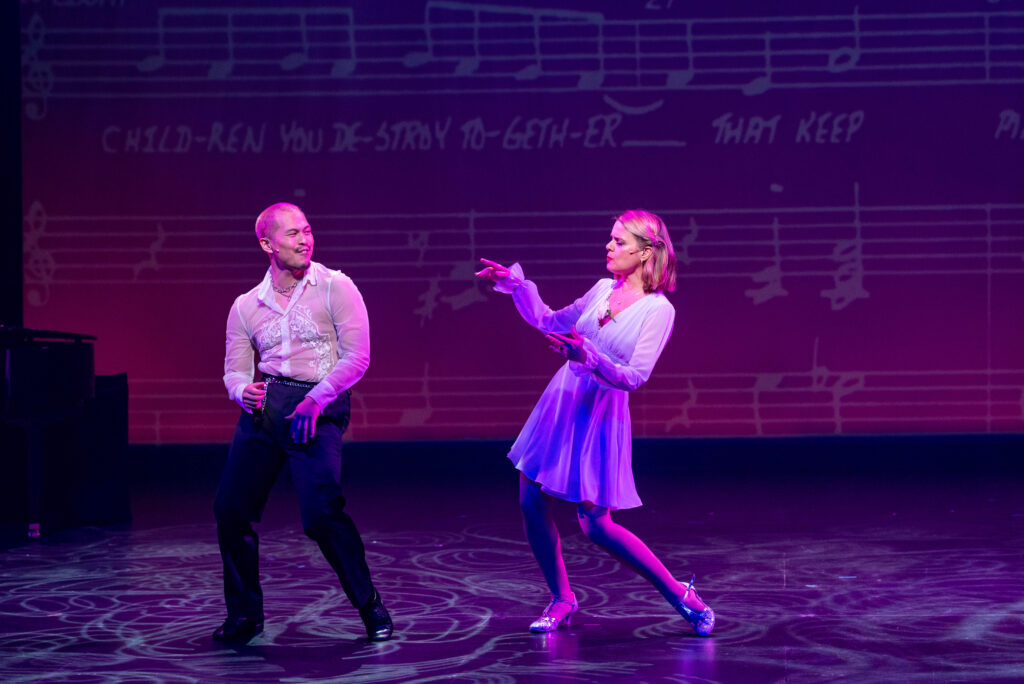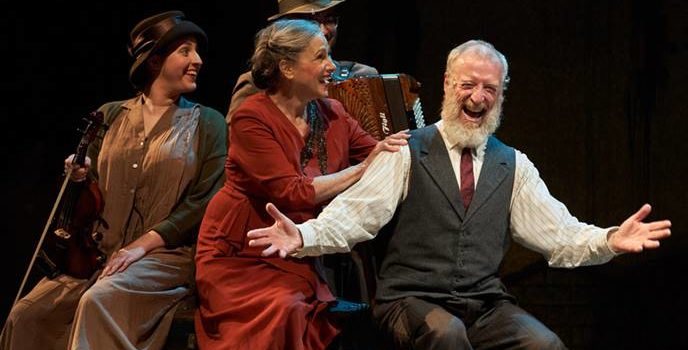By Lynn Venhaus
A poorly executed musical revue, “Side by Side by Sondheim” is miscast and misguided.
The Repertory Theatre of St Louis’ production hasn’t jelled yet, and on Feb. 3, the result was a tepid tribute to one of the greatest composers and lyricists in Broadway history.
That’s particularly disappointing because of The Rep’s previous presentation of its Sondheim masterpieces “Follies,” in 2016 and “Sunday in the Park with George” in 2012.
Phoenix Best, Paul HeeSang Miller, Saidu Sinlah and Amy Spanger are the quartet of singers that rarely appear as a cohesive unit. Think of it less as side by side and more as standing by themselves and not in sync with the others.
Their ‘70s-style Vegas dance moves, designed by Heather Beal, are at different stages and they often appear lazy and repetitive as they ‘do their own thing.’
Not sure where the disconnect began, especially when you have 28 songs spanning Sondheim’s landmark canon. Perhaps the addition of an older, seasoned vocalist or two would have helped ground it – the revue cast has shifted over the years, and once had a female trio, not duo. And the two here are not up to any kind of heavy lifting together for the vocal demands of Sondheim.
Given Sondheim’s penchant for games and puzzles (the film “Glass Onion: A Knives Out Mystery” is dedicated to him, and he makes a brief appearance), the mystery is thus: Have these singers ever been in a Sondheim show? Seen one?
Was there a vision for the production other than let’s slap-some-Sondheim tunes together? Reggie D. White, the new associate artistic director, took charge of this runaway train, which seems like an afterthought, and it never felt polished or had much pizzazz the entire runtime.
The range of unprepared musical numbers is the most blatant misstep. Occasionally, the harmony works, but mostly, we have singers not able to stick the landing, which is criminal with Sondheim.

Yes, his music is challenging and complicated. You need singers at the top of their game, but you also need singers who feel the emotional level of his work. He’s all about the feels. You can’t fake it. Finish the hat, dammit!
The man reinvented the modern musical, and we’re reducing his music to punch lines? That seems the focus here — let’s milk as much for laughs as possible, the bawdier, the better.
This revue is two hours and 15 minutes, with a 15-minute intermission. The sections are tied together by a narrator, who explains a common theme or background about a song. Or nuggets like how Oscar Hammerstein was a mentor.
Veteran pro Alan Knoll is charming and witty as the narrator, knowing how to work a crowd. He provided interesting tidbits about Sondheim’s recurring themes, particularly marriage. He was a late addition to the cast, hence, the notecards. (The program originally listed Miller as the narrator).
Sondheim’s collaborations with other composers – Jule Styne, Leonard Bernstein, Mary Rodgers, and Richard Rodgers among them – are an important part of the narrative here. And Knoll points out his lesser-known works, for laughs.
But it shouldn’t be all Shecky Greene-yucks without the perspective of the man’s greatness. This cast seems incapable of grasping his lyrical complexities and the level of sophisticated music, especially when they are in sequined and gaudy outfits going through awkward motions. (White satin hot pants, really?)
Costume Designer Oona Nateson has found a theatrical grab bag of ubiquitous black apparel augmented by shiny fabrics, leather pants and unnecessary sequins, some of it ill-fitting for their frames. The junior high talent show called and needs their hot pink satin disco shirt back.
After Sondheim’s death at age 91 on Nov. 26, 2021, the world put his loss in perspective and the tributes haven’t stopped.
His work should never be a museum piece – it should be as vibrant as ever – witness “Company” winning a Tony last year for Best Revival of a Musical and an acclaimed version of “Into the Woods” that kept being extended until recently, with plans of it touring (I saw this sublime stunner at the St. James Oct. 1, with Patina Miller, Joshua Henry, and Gavin Creel. It’s a must-see for the ages.). Locally, we had two superb “A Little Night Music” presentations last year, at Union Avenue Opera and Stray Dog Theatre, and the Muny’s resplendent “Sweeney Todd,” which we will be talking about for years to come. A brilliantly interpreted “Assassins” was staged by Fly North Theatricals last summer.
So, the lack of nuance in favor of a good-time variety hour reminiscent of one of those summer replacement shows networks were fond of back in the 1960s and 1970s, is perplexing.
Could we not be entertained merely by exquisite vocals transporting us to various times and places? The sense of wonder and human connection that often arises when a Sondheim show delivers a moment is nowhere to be found here.
To my surprise, Tre’von Griffith is listed as the music director, and I had more faith in his ability to interpret Sondheim’s genius. Did the creatives underestimate the time necessary to put it all together?
Sadly, the songs from “Company” and “West Side Story” seem the most adversely affected, like when those singing “Tonight” can’t hit the upper notes, and it is painful. The women’s duet, “A Boy Like That” is OK until it veers into a wobbly rendition of “I Have a Love.”
The women forgot lyrics to “Getting Married Today,” which is performed slower in tempo than usual, lacking the punch of the original.
Amy Spanger is entrusted with singing “Another Hundred People,” and several other big numbers that she is incapable of nailing, and it’s a travesty. The weakest link of the four, she has difficulty staying on key and enunciating, and instead, often goes for broader dance moves – and tugging at her too-tight sequined mini-dress.
During “Broadway Baby,” the LED screen shows some of her Broadway roles behind her, including Roxie Hart in “Chicago,” as if to remind us she’s been on a big stage before. Her list of credits is extensive, that’s why it’s so hard to believe she can’t hit notes. Her casting is a head-scratcher as she is clearly out of her depth.
Paul HeeSang Miller started strong, with Company’s restored gem “Marry Me a Little,” and so did Saidu Sinlah with “I Remember,” from “Evening Primrose,” but he faded fast, incapable of rising to the occasion the rest of the show.
The four don’t seem to have much chemistry and relied on the vaudeville-type schtick for laughs.
Because of these lackluster renditions, you find yourself thinking of better versions that you’ve heard before. I’m just grateful this is an earlier revue, so they don’t ruin “Into the Woods,” “Assassins,” “Sunday in the Park with George,” “Sweeney Todd” and “Merrily We Roll Along” in any way.
Phoenix Best, who benefits from a comedic approach to some numbers, delivers an effective “I’m Still Here” and “Send in the Clowns,” but tended to go louder when unsure during other numbers. Her solos were often introduced with her making an entrance to build up the drama.
The women often relied on ‘kittenish,’ playing up the double entendres in “Can That Boy Foxtrot,” which was cut from “Follies.”
In a slinky leotard, Best stretched out “I Never Do Anything Twice” from the film, “The Seven-Percent -Solution,” using a chaise lounge to drape herself over.
And the crowd-pleaser, “You Gotta Get a Gimmick” by the strippers in “Gypsy,” draws laughs over the women’s well-placed percussion.
Those unfamiliar with “Follies” get a lesson on different musical styles, especially vaudeville, but then Spanger attempts “Losing My Mind,” and it was my clench-fist time. I may have blurted out “Please don’t let her sing this” instead of just thinking it to myself. (Sorry to my neighbors).
The guys singing “Bring on the Girls” is nearly laughable.

When the show delves into the lesser-known works, expectations are lowered, but the butchering of “Pretty Lady” from “Pacific Overtures” by all four was excruciating. Was anyone on key?
The production design by Camilla Tassi consists of slides showing Sondheim at various stages of his life, and the New York milieu, which is so important to his work.
If you are a Sondheim fan, one can appreciate accompanists Stephen A. Eros and Kris Pineda, whose piano work is stellar.
The sound, designed by Sharath Patel, however, has some rough moments.
But the whole affair smacks less of collaboration and more self-preservation than any serious performance piece. When they move four chairs around on the set, I was reminded of the deck of the Titanic, where the band played as doom closed in around them.
This production should not be considered an introduction to Sondheim, for you can find multiple tributes online that celebrate his artistry in better ways.
The outstanding documentary, “Six by Sondheim,” is currently streaming on HBOMax, and can be rented on various video on demand platforms. This is a sensational piece that tells you all you need to know, and is time much better spent than at COCA.
One wonders why this show replaced another Sondheim revue, “Putting It Together,” from 1992, which had been on The Rep’s schedule.
But this is a colossal waste of resources – there needed to be an assistant costume designer, assistant sound designer and two assistant directors?
The man who won eight Tony Awards, an Academy Award, eight Grammy Awards, a Olivier Award, a Pulitzer Prize, a Kennedy Center Honor, and a Presidential Medal of Freedom deserved better.
If you are not going to give Sondheim his proper due, then what’s the point? Maybe start by hiring singers who have the compatible vocal range for the songs?
The Repertory Theatre of St. Louis presents “Side by Side by Sondheim” from Jan. 29 through Feb. 19 at the Catherine Berges Theatre at the Center for the Creative Arts (COCA). For more information or tickets, visit www.repstl.org.


Lynn (Zipfel) Venhaus has had a continuous byline in St. Louis metro region publications since 1978. She writes features and news for Belleville News-Democrat and contributes to St. Louis magazine and other publications.
She is a Rotten Tomatoes-approved film critic, currently reviews films for Webster-Kirkwood Times and KTRS Radio, covers entertainment for PopLifeSTL.com and co-hosts podcast PopLifeSTL.com…Presents.
She is a member of Critics Choice Association, where she serves on the women’s and marketing committees; Alliance of Women Film Journalists; and on the board of the St. Louis Film Critics Association. She is a founding and board member of the St. Louis Theater Circle.
She is retired from teaching journalism/media as an adjunct college instructor.


